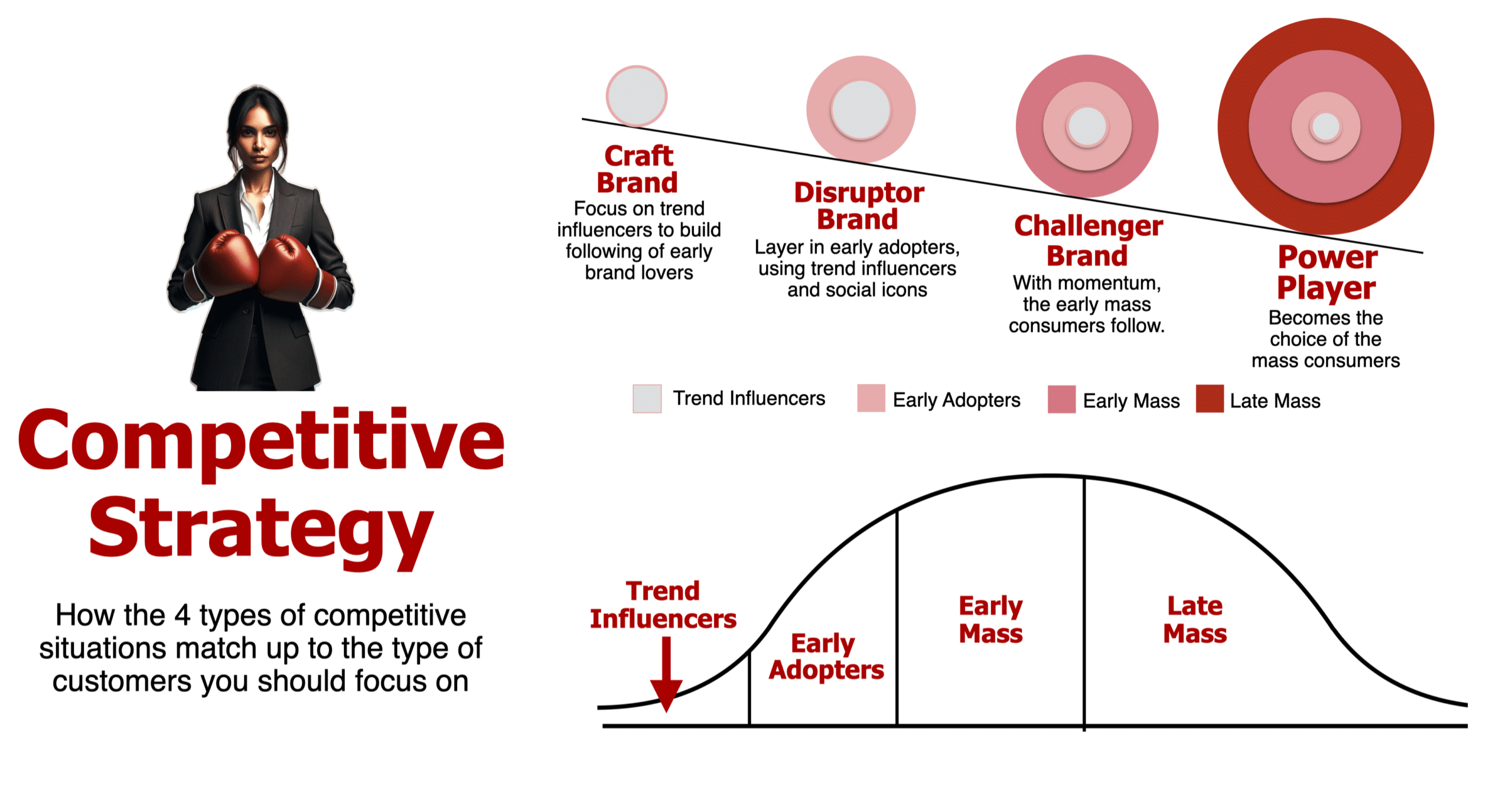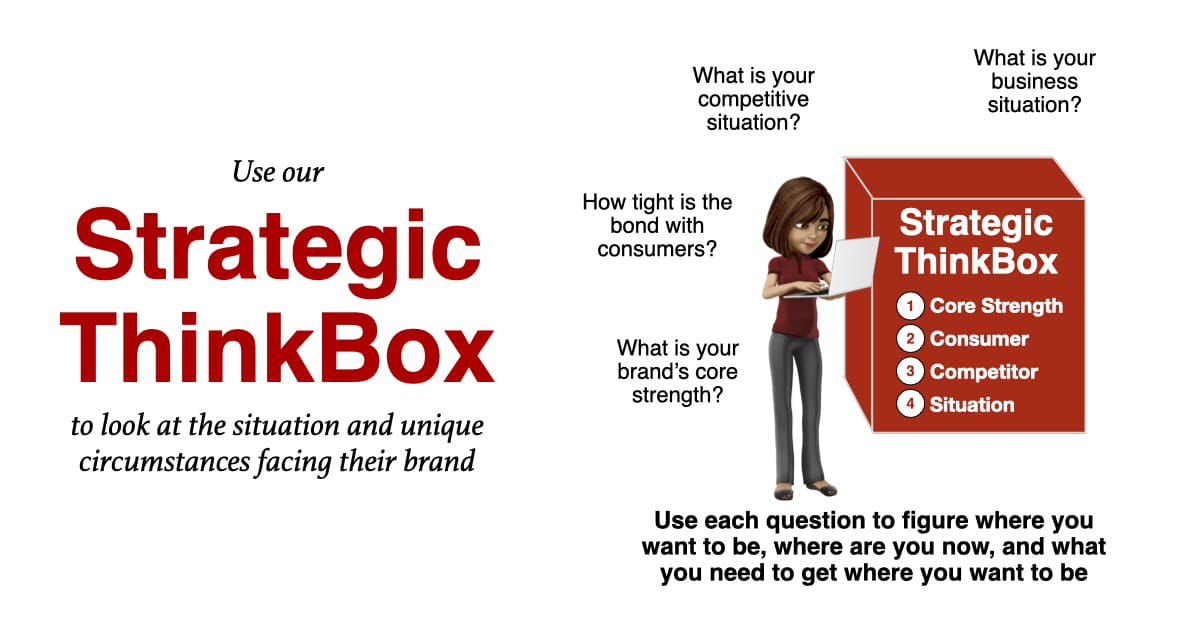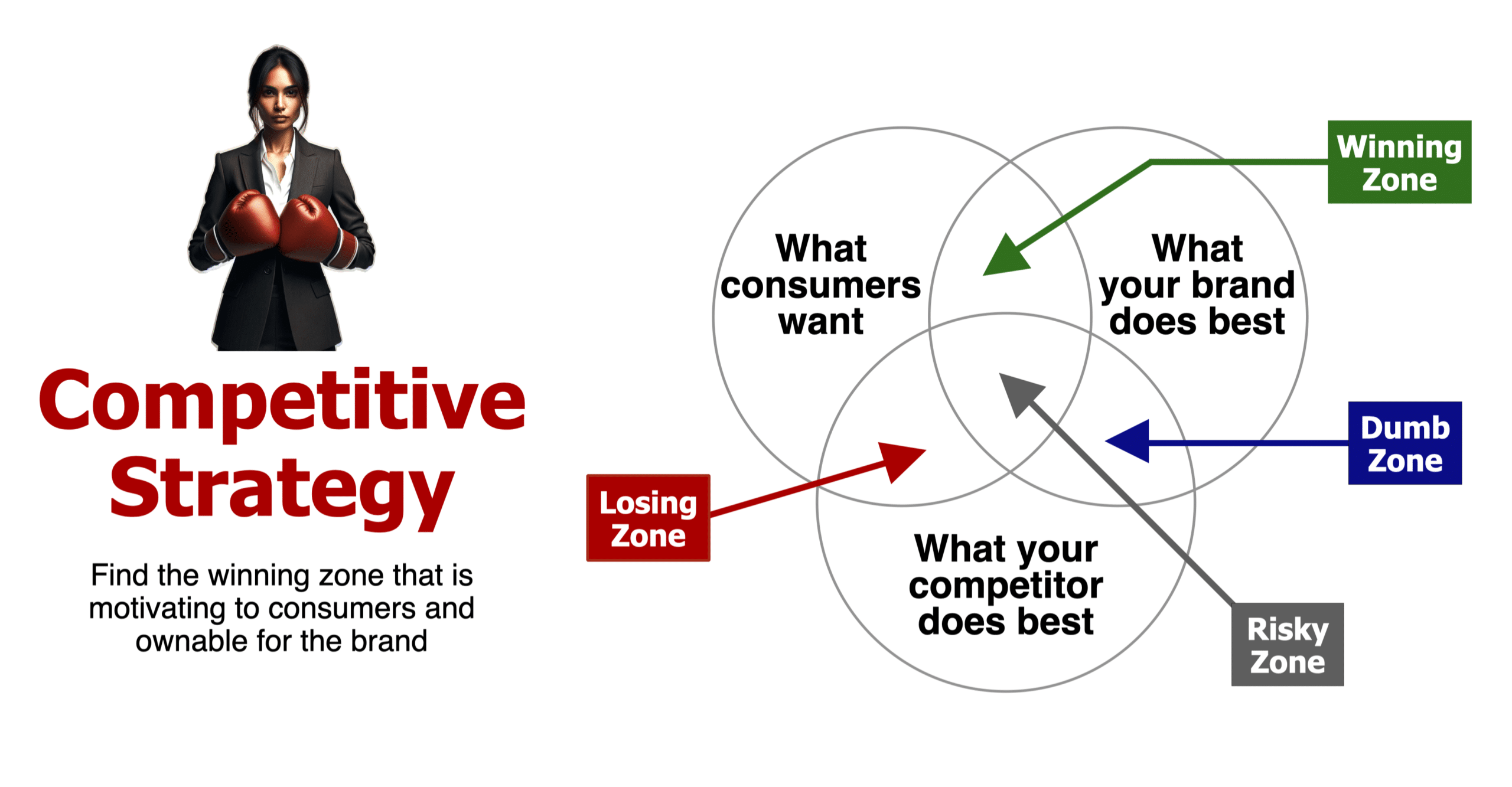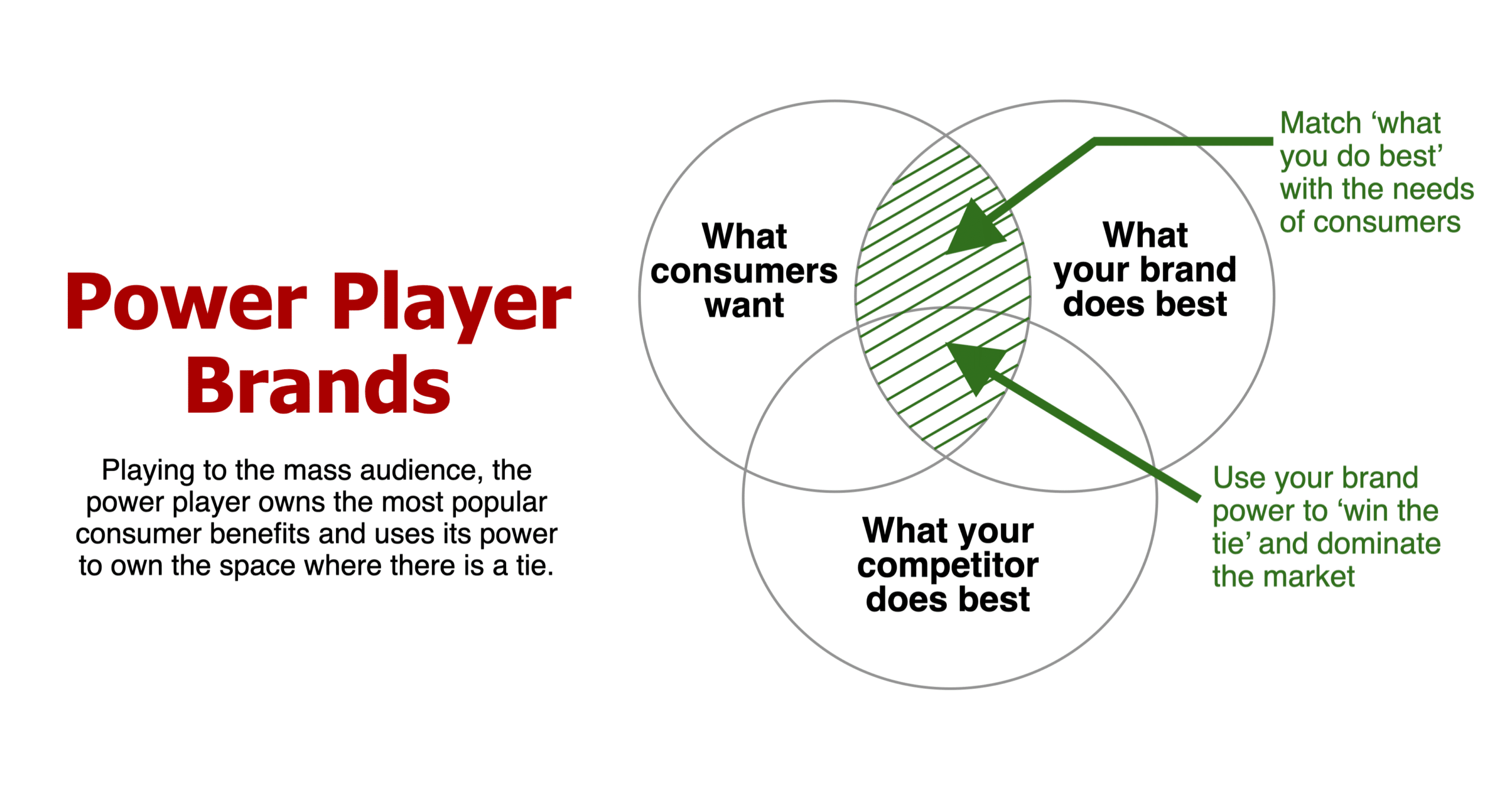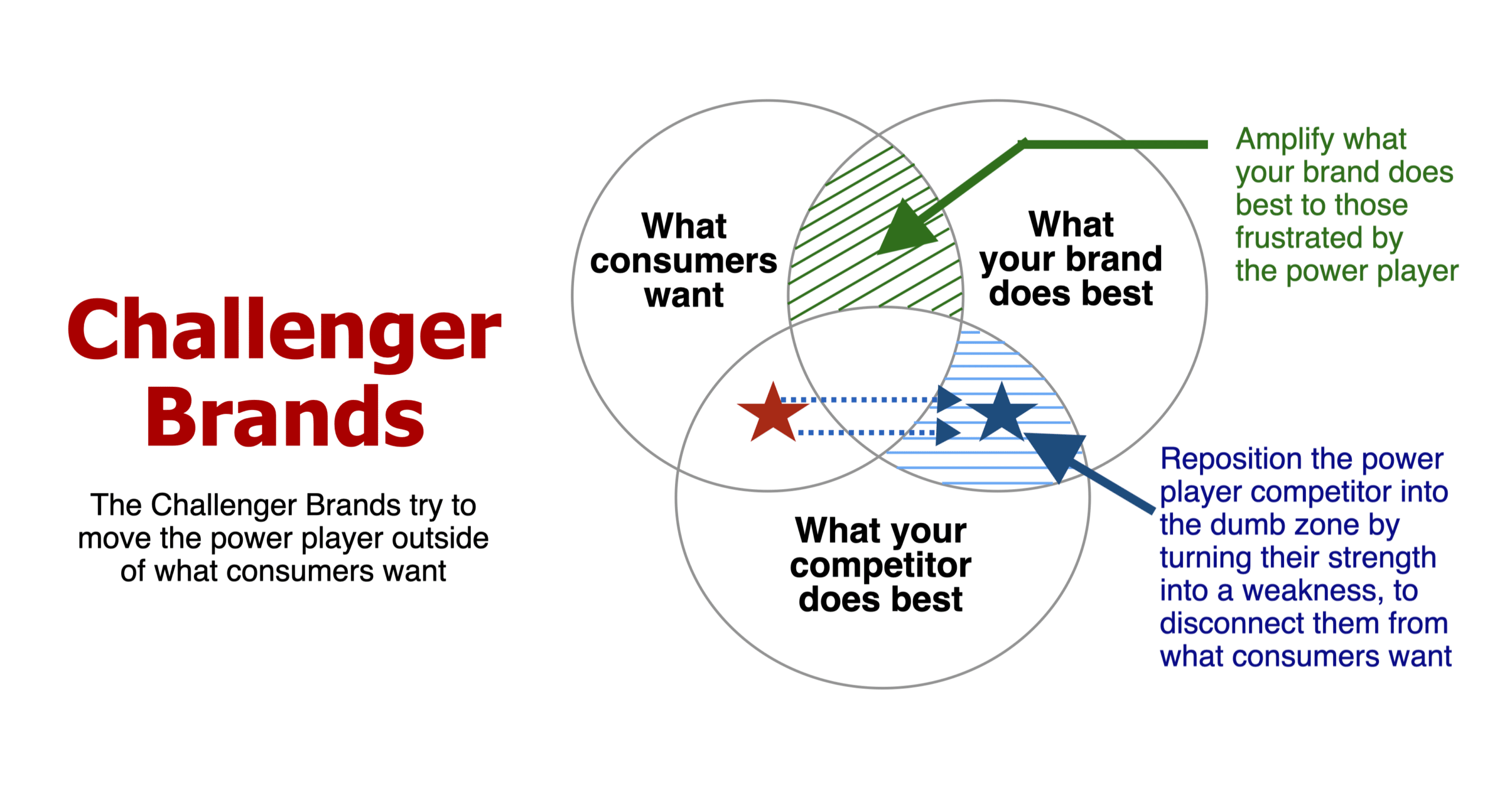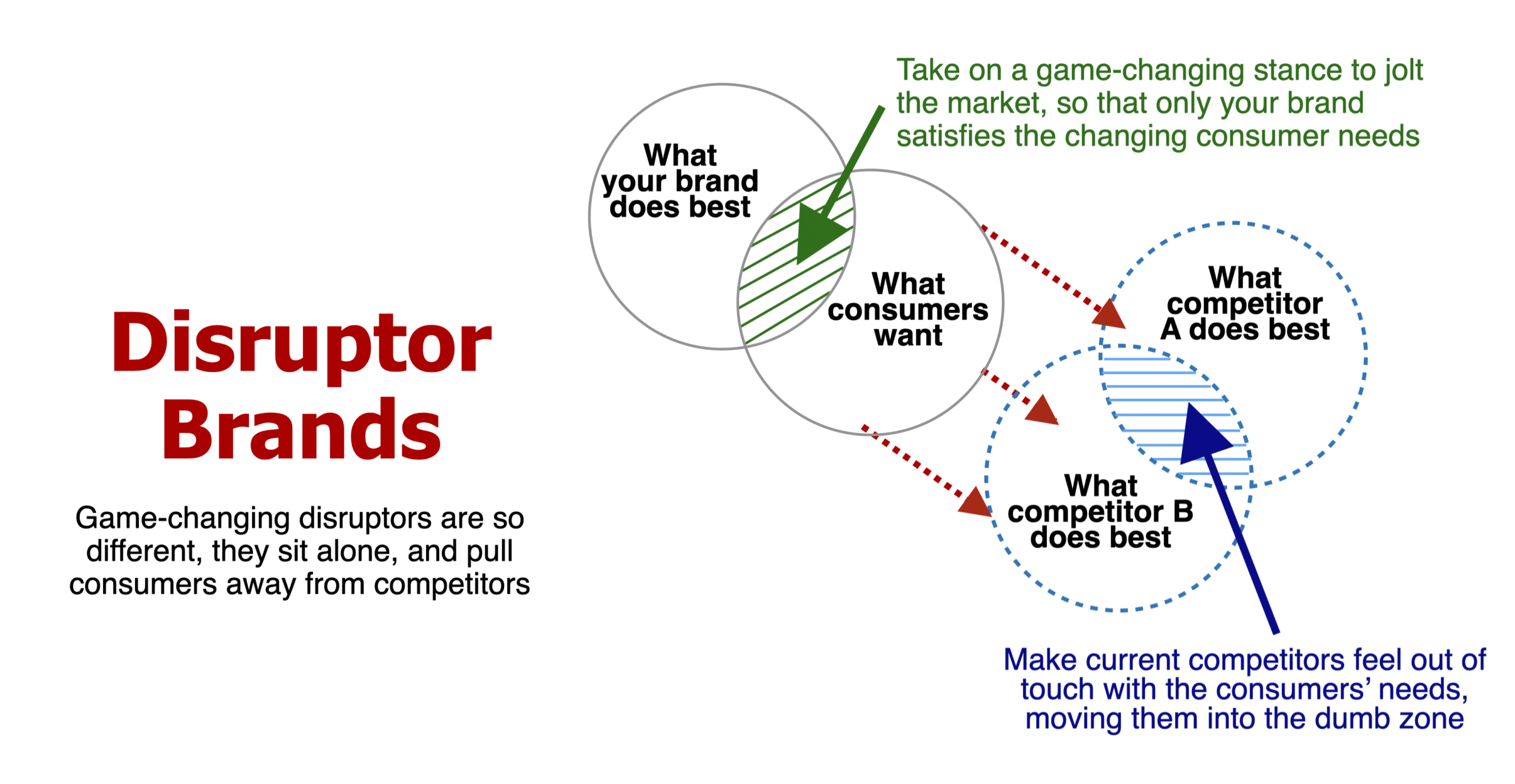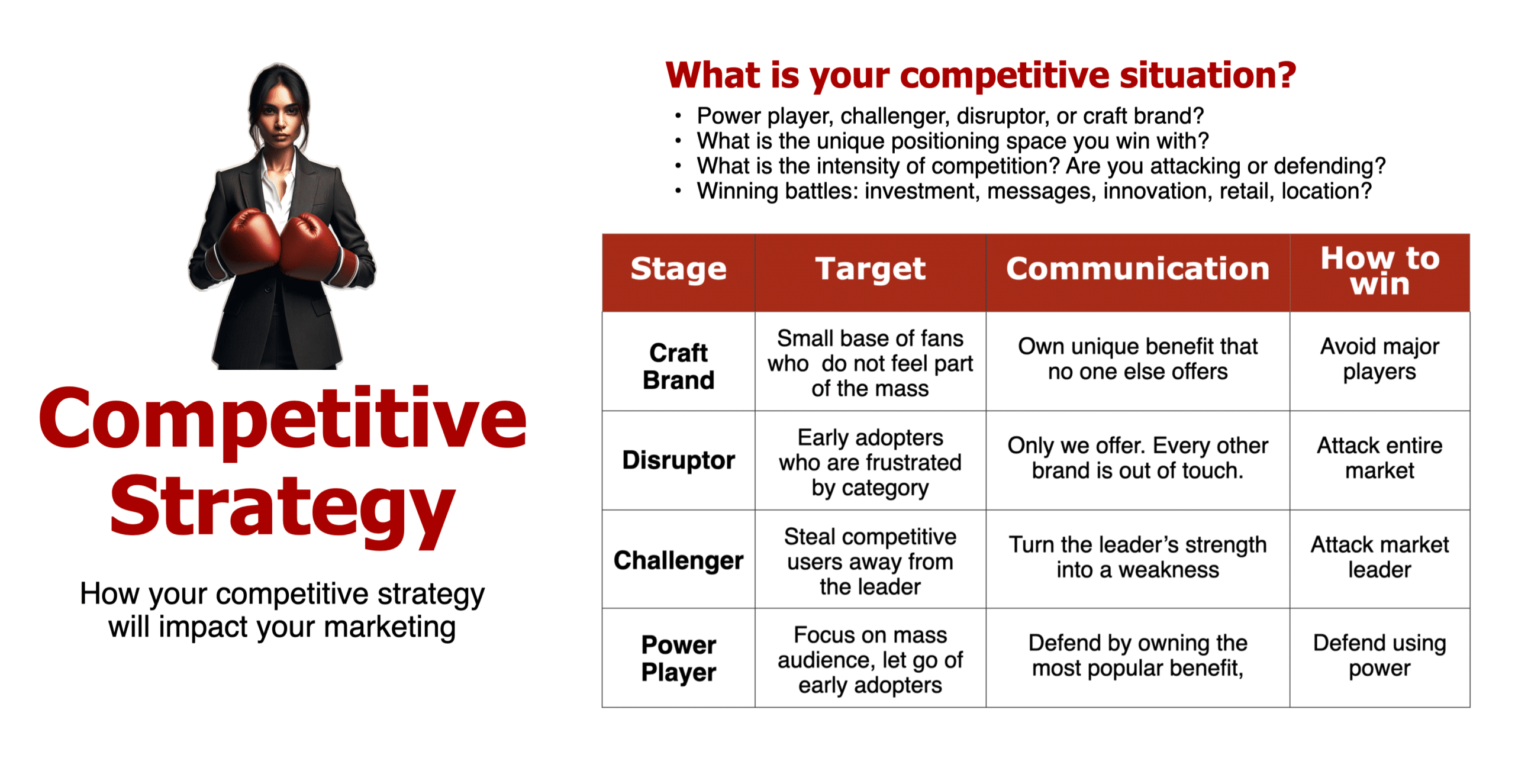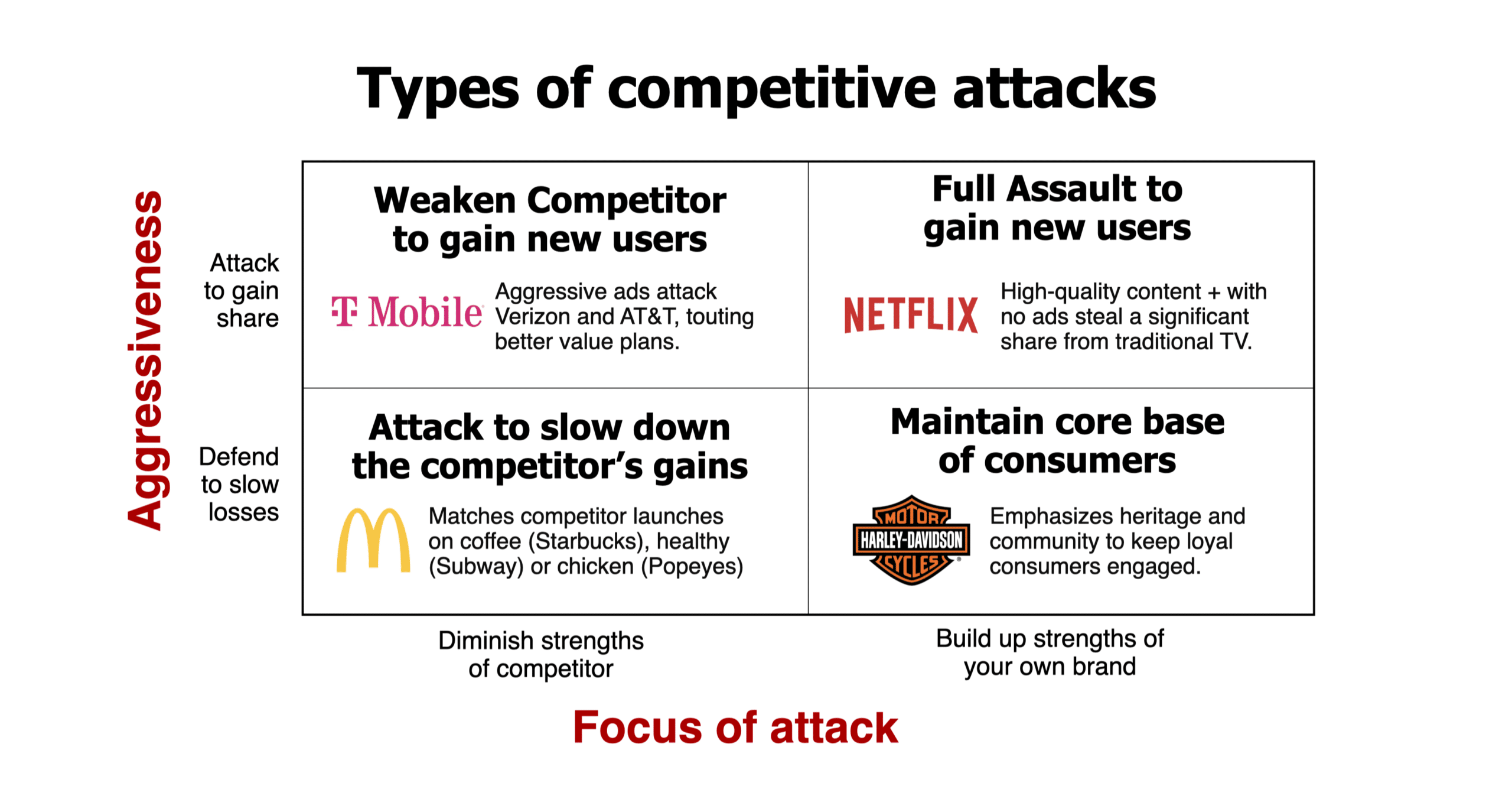In our article, I will outline four types of competitive brand strategy situations: the power player, challenger brand, disruptor brand, and craft brand. Our model will challenge you to identify and choose one competitive situation that best fits where you are today and where you want to go next.
Using the innovation curve to look at the 4 types of customers
Below is an image that helps explain the competitive brand situations. The curve at the bottom of the chart represents the typical adoption curve in which customers can be segmented based on their willingness to try new products or adopt new trends. It visually aligns each type of brand strategy with the consumer group most relevant at each stage of growth.
- Trend Influencers: Innovators, the first to adopt
- Early Adopters: Those who follow trends closely but wait to see some initial success
- Early Mass: Consumers who begin to purchase once the product is more widely accepted
- Late Mass: The largest and most risk-averse group, which adopts after the product has become mainstream
This framework is designed to help businesses understand where they are in their brand evolution and identify the customer groups they should prioritize to drive growth.
To illustrate, click on the competitive strategy diagram to zoom in.
The Competitive Strategy image above illustrates the 4 types of competitive brand strategies and how they align with different stages of consumer adoption, providing insight into which customer groups brands should prioritize at each stage of growth:
Craft Brand:
Target Audience: Trend Influencers
- At the initial stage, brands focus on building a small but dedicated following of trend influencers. These are the early, passionate adopters who can help generate buzz and credibility around the brand. By appealing to this niche group, a brand can establish itself as a unique and exclusive option that stands out from the competition.
Disruptor Brand:
Target Audience: Early Adopters
- As the brand gains traction, it transitions into the role of a disruptor by expanding its appeal to early adopters. This stage involves using social icons and trend influencers to maintain momentum and expand the brand’s reach. Disruptor brands leverage their innovative or differentiated value propositions to convince a larger, yet still selective, group of consumers to buy into their offering.
Challenger Brand:
Target Audience: Early Mass
- With increased momentum, the brand begins to attract a broader audience—specifically the early mass market. At this point, the brand is no longer just a niche or disruptive entity but starts to challenge the established leaders by appealing to a wider consumer base. This phase is critical for building market share and brand awareness, as the early mass follows the lead set by trend influencers and early adopters.
Power Player:
Target Audience: Late Mass
- Once the brand has established a strong position, it becomes a “Power Player” in its category. In this stage, the brand becomes the go-to choice for the late mass of consumers, who often represent the majority of the market. These consumers are typically more conservative, preferring established, reliable brands. The focus here is on maintaining dominance and solidifying the brand’s status as the leader in its space.
Competitive Strategy - Table of Contents
Brand strategy
Our Strategic Thinkbox looks at core strength, the consumer bond you have, the competitive situation you face. I’ve always believed that strategic thinkers see questions before they see solutions. Ever hear someone say, “That’s a good question?”
It means someone just asked an interruptive question, designed to slow everyone’s thinking, so they reflect and plan before they act.
The strategic thinking side of marketing is logical and helps you map out a range of decision trees that intersect, by imagining how events will play out in the future.
With this in mind, I created the Strategic ThinkBox, which asks questions that set up your strategy. We look at four strategic questions to force you to look at:
- Core strength.
- Consumer Strategy.
- Competitive Strategy.
- Business Situation.
To illustrate, click on the competitive strategy diagram to zoom in.
Competitive Strategy
To find the competitive space in which your brand can win, I introduce the Venn diagram of competitive situations. Looking below, the first circle should list out everything the consumer wants. The second circle then lists everything your brand does best. And, finally, the third circle lists everything your competitor does best.
To illustrate, click on the competitive strategy diagram to zoom in.
To win, brands have to find the space where they are better, different, cheaper…or else they will not around for very long.
We’ll show how to find your brand’s winning zone. Essentially, you have to match up what consumers want with what your brand does best. This provides you a distinct space that you can own and defend from attack. To maintain ownership over that space, your brand should always be able to satisfy the needs of the consumer better than anyone else can.
Your brand will not survive in the losing zone. This space matches up the consumer needs with the area where your competitor does it better than your brand. It is dangerous to try to play in this space, because over the long term, your competitor will beat you.
Brands can win the risky zone
As markets mature, competitors copy each other. It becomes harder to be better with a definitive product win. And that leaves you to play in the risky zone, which is the space where you and your competitor both meet the consumer’s needs in a relative tie. The tie is important to understand, because brands can still win the tie when they make their brand seem different enough that consumers perceive the brand to be better. Perception becomes reality.
There are four ways to win the risky zone:
- Leverage your brand’s power in the market to squeeze out lesser brands.
- Be the first to capture and defend the space.
- Win with innovation and creativity.
- Find ways to build a deeper emotional connection.
Sadly, I do have to always mention the dumb zone where two competitors “battle it out” in the space where consumers do not care. One competitor says, “We are faster” and the other thinks, “We are just as fast”. A competitive war starts up, yet no one bothered to ask the consumer if they care. That’s dumb.
Beloved Brands Marketing Training
To view, use the arrows to see our Beloved Brands Marketing Training program brochure.
It's time to elevate your marketing team's performance with our Beloved Brands Marketing Training program.
Our marketing training makes your marketers smarter with brand analytics, strategic thinking, brand positioning, brand plans, and marketing execution.
Competitive situations
Brands rarely experience competitive isolation. Even in a blue ocean situation, the euphoria of being alone quickly turns to a red ocean, cluttered with the blood from nasty battling competitors. The moment we think we are alone, a competitor is watching and believing they can do it better than we can. When you ignore your competition, believing only the consumer matters, you are on a naive pathway to losing. Competitors can help sharpen our focus and tighten our language on the brand positioning we project to the marketplace.
Regarding marketing war games, I will use this Venn diagram to map out four types of competitive brands:
- Power players
- Challenger brands
- Disruptor brands
- Craft brands.
Power Player brands
Power players lead the way as the share leader or perceived influential leader of the category. These brands command power over all the stakeholders, including consumers, competitors, and retail channels.
Regarding positioning, the power player brands own what they are best at and leverage their power in the market to help them own the position where there is a tie with another competitor.
Owning both zones helps expand the brand’s presence and power across a bigger market. These brands can also use their exceptional financial situation to invest in innovation to catch up, defend, or stay ahead of competitors.
Power player brands must defend their territory by responding to every aggressive competitor’s attacks.
They even need to attack themselves by vigilantly watching for internal weaknesses to close any potential leaks before a competitor notices. Power player brands can never become complacent, or they will die.
To illustrate, click on the competitive strategy diagram to zoom in.
Google Example
One of the best contemporary power player brands is Google, which has managed to dominate the search engine market. The company’s extreme focus and smart execution gained market power and squeezed out Microsoft and Yahoo. Focused on providing knowledge for consumers, Google has continued to expand its services into a bundle of products with e-mail, maps, apps, docs, cloud technology, and cell phones.
Regarding advertising dollars, the combination of Google and Facebook now accounts for over 80% of all digital advertising spending. We are currently entering the digital duopoly age with influence shared between these two power player brands.
Challenger brands
Challenger brands must change the playing field by amplifying what your brand does best while simultaneously repositioning the power player brand you want to take down.
While your first instinct would be to attack the power player’s weakness, the smarter move is to reposition one of the power player’s well-known strengths into a perceived weakness. This strategy helps move the power player brand outside of what consumers want.
When you attack a power player brand, be ready for the leader’s potential defensive moves and anticipate a response with full force, as the power player brand has more significant resources than you. Be highly confident that your attack will make a positive impact before you begin to enter into a war. The worst situation is to start a war, you cannot win, as it will drain your brand’s limited resources, only to end up with the same market share after the war.
Since the power player leader tries to be everything to everyone, you can narrow your attack to slice off those consumers who are frustrated with the leading brand. Tap into their frustration to help kickstart a migration of consumers away from the leader. If you can gain these lost consumers, you can quickly change share positions.
To illustrate, click on the competitive strategy diagram to zoom in.
The Pepsi Challenge
One of the best examples of a challenger brand that made significant gains is the Pepsi Challenge from the 1970s. It was a direct offensive attack on Coke. In blind taste tests, Pepsi was the preferred brand. Pepsi is a much sweeter taste, so in a quick hit, it was the chosen brand. Coke is an acquired and memorable taste. The blind taste test took away the Coke brand name and the emotional feelings of that brand. At the same time, Pepsi amplified its strength as the “new generation” and positioned the brand as the solution to consumers ready to reject the “old taste” of Coke. This approach was so powerful it was even a contributing factor to the launch of a sweeter “New Coke.”
Take your brand knowledge to new heights with our Beloved Brands playbook
Beloved Brands is a comprehensive guide that covers the fundamentals of brand management. It goes deep on strategic thinking, brand positioning, brand plan development, advertising decisions, media planning, marketing analytics, and the brand financials. This is an opportunity to build your marketing skills to help your career. And, it will provide you with the roadmap for driving growth on your brand.

Marketers see Beloved Brands playbook as a go-to resource, as they keep it within arm’s reach for any new project. We are thrilled to see that it has received a 5-star rating from nearly 90% of Amazon reviewers. Additionally, we have also created playbooks for B2B Brands and Healthcare Brands, catering to specific industries.
Disruptor brands
Disruptor brands move into a blue ocean space, alone. They use a new product, distribution channel, target market, or price point. These brands are so different that they appear to be the only brand that can satisfy the consumer’s changing needs.
When successful, the disruptor brand repositions the major players, making them appear unattached to consumers.
While everyone wants a game-changer, it is a high-risk, high-reward competitive situation. The trick is you have to be “so different” to catch the consumer’s attention and mindshare. Being profoundly different increases the risk you may fail. Also, your success may invite other entrants to follow. At that point, you become the new power player of the new segment. You have to continue attacking the major players while defending against new entrants who attack your brand.
To illustrate, click on the competitive strategy diagram to zoom in.
Technology disruptors
Uber, Netflix, and Airbnb are contemporary brands that effectively use modern technology to create such a unique offering that they cast major category-leading brands or entire industries as outdated and outside what consumers want. Uber disrupted the taxi market, Netflix is revolutionizing the way we watch TV, and Airbnb has had a dramatic impact on hotels. These brands have a smarter ordering system, better service levels, and significantly lower prices.
Craft brand
Craft brands must win a small space in the marketplace that offers something unique to a highly engaged target. These brands succeed when they are far enough away from major competitors that the leaders ignore them because craft brands stay hidden away.
Craft brands build themselves behind a micro-benefit, including gluten-free, low fat, locally grown, organic or ethically sourced. These craft brands take an antagonistic approach to the rest of the category, portraying every other brand in the category as old-school, overly corporate, unethical, flawed in the manufacturing or the use of ingredients. Many times, these brands take a very aggressive marketing stance, calling out the other brands as unethical or stupid. Craft brands believe it is better to be loved by the few than liked or tolerated by many.
To illustrate, click on the competitive strategy diagram to zoom in.
Five Guys
A fantastic of example a craft brand is Five Guys Burgers, which uses fresh, high-quality beef and a commitment not to begin cooking your burger until you order it. The portions are more substantial than typical fast food, and they charge super-premium prices. Five Guys have gone in the opposite direction to most fast food restaurants, whose meals seem frozen and microwaved. They expanded rapidly with word-of-mouth helping the brand earn a reputation as “the best burger.” Now that Five Guys has become a global brand, McDonald’s has to figure out an adequate competitive response.
Dollar Shave
Another excellent example of a craft brand is Dollar Shave, which launched as an online subscription model for razor blades. Dollar Shave uses smart sourcing and a direct-to-consumer distribution model. This efficient model eliminates costs and allows the brand to sell razors at a fraction of the cost you pay for Gillette. For consumers, the price of razor blades has gotten out of control, no matter how much innovation the leaders try to portray. Dollar Shave’s advertising openly mocked Gillette, yet it started in such a small niche, so Gillette ignored them. While year one sales were only $30 million, without a competitive response from Gillette, Dollar Shave continued to grow year-by-year, until Unilever recently purchased the brand for $1 billion.
Brands must evolve their strategy as they move from the craft brand to the power player brand
To illustrate, click on the competitive strategy diagram to zoom in.
Many brands start in someone’s garage or over a kitchen table at midnight
Start-ups should deploy a craft brand strategy. To stand out, you must be utterly different to a core group of trend influencers who are frustrated with the major competitors. You must be willing to take a “high risk/high reward” strategy. It is O.K. if your brand alienates those who are not yet ready to take on something new. Playing it too safe will lead to your destruction. Do not worry about the mass audience, and avoid trying to be too big, too fast.
As your brand grows, you can transition to a disruptor brand strategy. Utilize your core audience of trend influencers to gain a core base of early adopters. While a craft brand attracts the attention of trend influencers, the disruptor brand must dial up its aggressive stance and call out the major brands. Use your significant point of difference to pull consumers away from the category-leading brands to make them seem detached from the needs of the consumer.
Lean into challenger strategy
As your brand continues to grow, you can use your increased resources and power to take on a challenger brand strategy against the leader. You can use the influence of the trend influencers and early adopters to attract the early mass audience.
With a significant consumer base, more brand power, and increased financial resources, your brand must gain hard-fought proximity, allowing you to go head-to-head with the power player leader.
The challenger brand should turn the leader’s strength into a weakness, pushing it out of what consumers want, while creating a new consumer problem for which your brand becomes the solution.
At the power player stage, the strategy shifts to maintaining your leadership position. You should take on a defensive strategy, to attack in response to any player who threatens your brand. While the trend influencers and early adopters played an essential role in making the brand a household name, you have to be comfortable that your earliest brand fans will eventually leave your brand and look for what is next. They may even call you a “sell-out.” Stay focused on the mass audience.
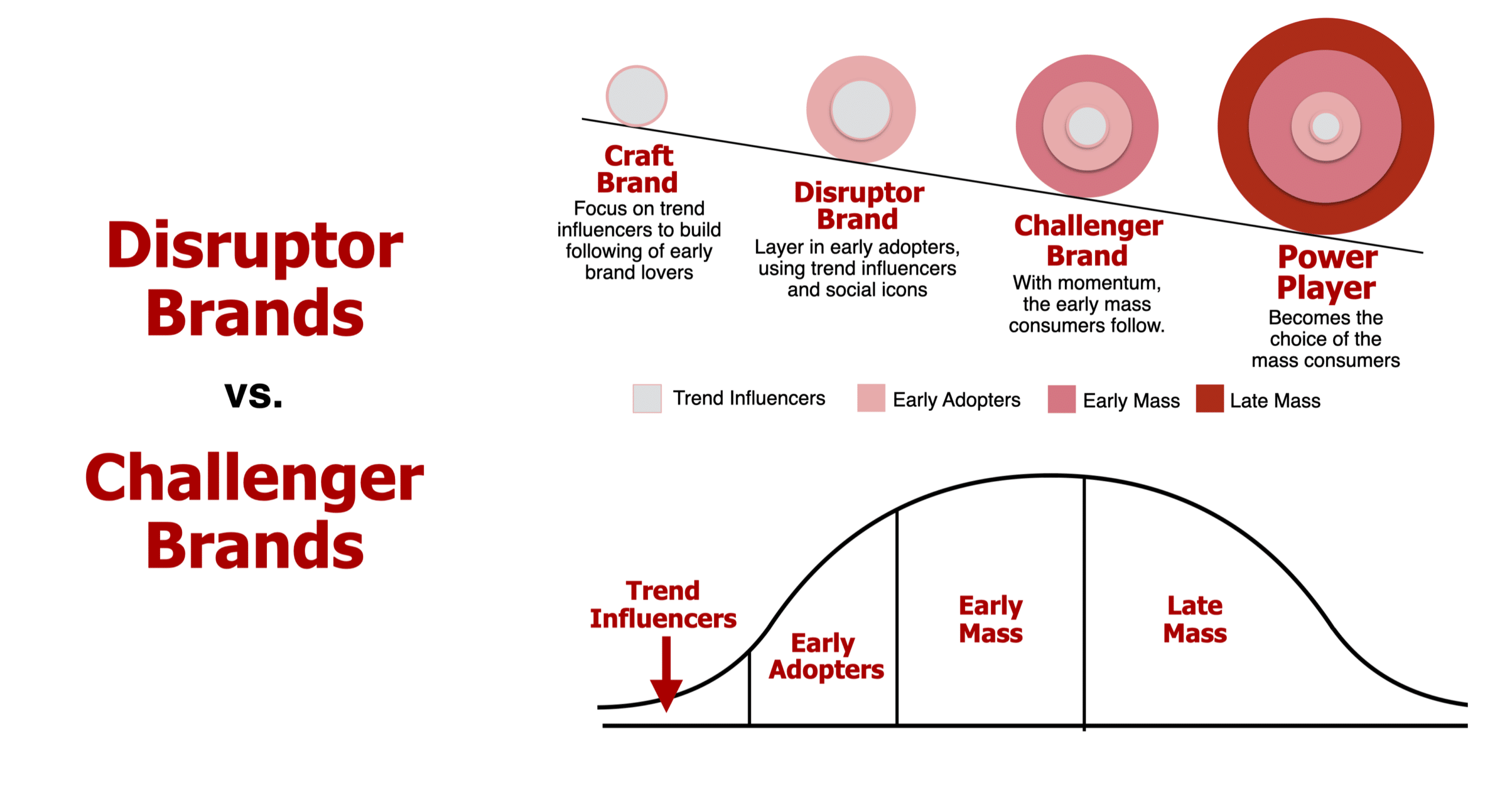
Competitive attack strategies
As you engage in competitive strategy, you must decide how aggressive you are willing to be, whether you wish to attack to gain share or defend to slow down any losses.
The other dimension is the focus of your attack, whether you will build up the strengths of your brand or diminish the strengths of your competitor. That leaves your brand with four strategic attack options:
Full assault
- You recognize an opportunity in the market where your strengths are considered superior to your competitor, and you see an opportunity to gain share. Focus on playing up your competitive advantage – whether you use your brand positioning, product innovation, or distribution channels – to enhance the purchase moment or the overall consumer experience.
Maintain strong core
- When you recognize attempts by an aggressive competitor, retreat and maintain your core audience by playing up the accepted strengths of your brand. This strategy can retain share against an aggressive competitor (or at least slow down the losses).
Weaken competitor
- When you recognize a dramatic weakness in your competitor, this opens up the opportunity to gain share by attacking your rival.
Slow down competitor
- When you recognize you are at a competitive disadvantage, attacking back on an element of your competitor can buy you time, so you can regroup behind the scenes to close the competitive gap. While you may lose share in the short term, once you have fixed that gap, you can look to rebuild your share by going back after any consumers you may have lost.
Video Lesson: Key Issues
To illustrate, watch our video on how to find the key issues on your brand that you can use in your marketing plan. Importantly, it helps you find the best possible questions. Subsequently, it sets up strategic solutions to answer those questions.
To illustrate, click on ▶️ to see our video on competitive strategy diagram to zoom in.


